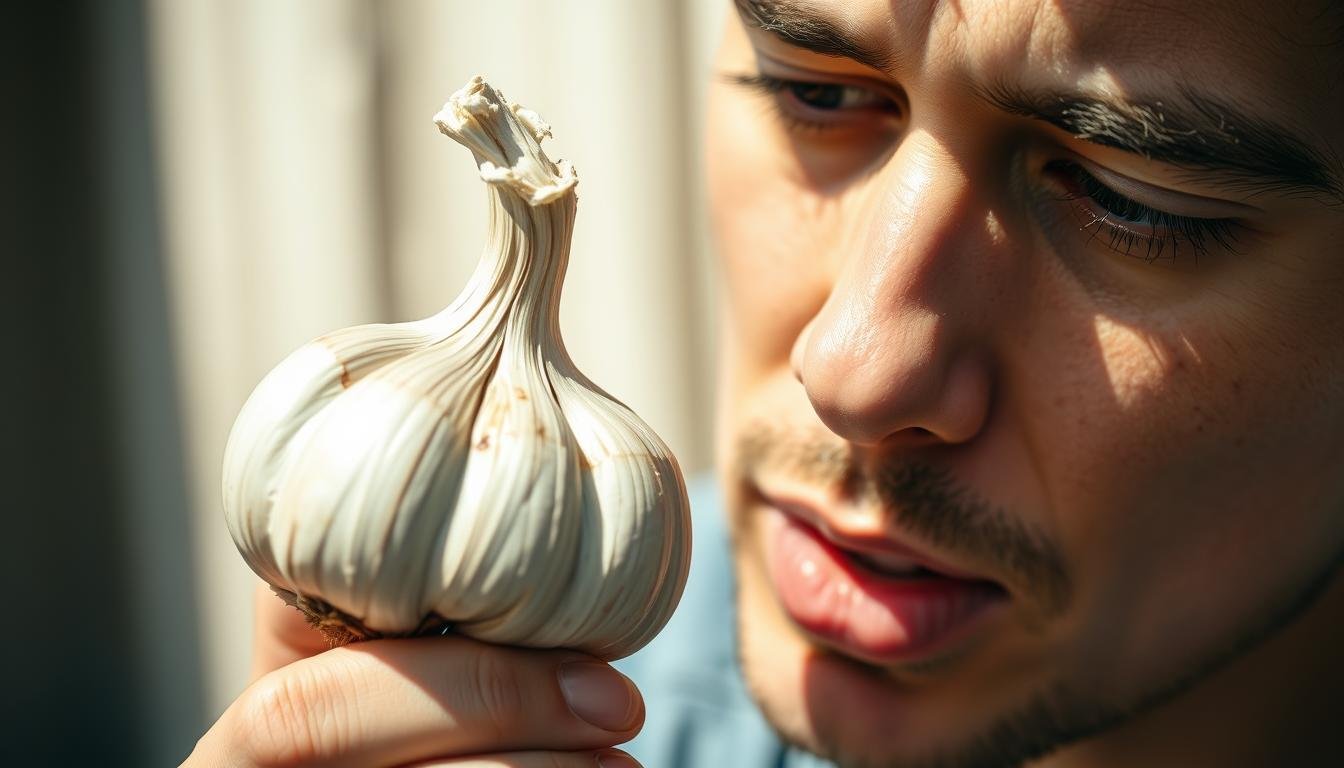Eat Garlic Straight from the Garden: Freshly harvested homegrown garlic is a culinary delight. But is it safe to consume raw garlic straight from your garden? Many gardeners wonder about the benefits and potential risks of eating garlic directly from their garden.
When thinking about enjoying your homegrown garlic, it’s key to know the safety, benefits, and best practices. This article will dive into these topics. It aims to give you the info you need to enjoy your garlic harvest to the fullest.
Contents
- 1 The Safety of Eating Fresh Garden Garlic
- 2 Can You Eat Garlic Straight from the Garden?
- 3 Understanding Garden Garlic Varieties
- 4 Harvesting Garlic for Immediate Consumption
- 5 Preparing Fresh Garden Garlic
- 6 Health Benefits of Fresh Garden Garlic
- 7 Potential Drawbacks of Eating Fresh Garden Garlic
- 8 Eating Garlic Straight from the Garden: A Safe and Delicious Choice
- 9 FAQ: Eat Garlic Straight from the Garden
- 9.1 Is it safe to eat garlic straight from the garden?
- 9.2 How do I know when my garlic is ready to eat?
- 9.3 What’s the difference between hardneck and softneck garlic?
- 9.4 Can I eat garlic raw?
- 9.5 How should I store freshly harvested garlic?
- 9.6 Are there any health benefits to eating fresh garlic?
- 9.7 Can eating garlic interact with any medications?
- 9.8 How do I clean garlic before eating it?
- 9.9 Can I use any variety of garlic for cooking?
- 9.10 How can I incorporate fresh garlic into my diet?
The Safety of Eating Fresh Garden Garlic
Fresh garden garlic is a treat, but before you indulge, it’s crucial to understand the potential risks involved. When you grow your own garlic, you’re not just cultivating a crop; you’re also responsible for ensuring it’s safe to eat.
Potential Contaminants in Fresh Garlic
Several contaminants can affect the safety of your garlic:
- Soil contaminants like heavy metals or pesticides
- Bacteria or fungi that can cause spoilage
- Pests or insects that might be hiding in the garlic
To mitigate these risks, it’s essential to handle your garlic properly. This includes:
- Washing your garlic thoroughly before consumption
- Inspecting your garlic for visible signs of damage or contamination
- Storing garlic in a clean, dry environment
By taking these precautions, you can enjoy your homegrown garlic while minimizing potential health risks.
Can You Eat Garlic Straight from the Garden?
Garlic is a versatile ingredient, and eating it straight from the garden is possible, provided it’s mature and properly harvested. When considering whether to eat garlic directly from your garden, the primary factor to assess is its maturity.
Garlic Maturity and Flavor
The maturity of garlic significantly affects its flavor and edibility. Immature garlic, often referred to as “green garlic,” has a milder flavor and can be used in various dishes. On the other hand, mature garlic has a stronger flavor and is typically harvested when the tops of the plants begin to yellow and fall over.
- Mature garlic has a stronger, more complex flavor profile.
- Immature garlic is milder and can be used similarly to green onions or leeks.
- The optimal time to harvest garlic depends on the variety and growing conditions.
Understanding the maturity of your garlic is crucial for enjoying it straight from the garden. By considering the variety and the signs of maturity, you can enjoy your garlic at its best flavor.
Understanding Garden Garlic Varieties
Different garlic varieties bring unique flavors and benefits to your kitchen and garden. Knowing the differences between them is key to making the right choices.
Hardneck vs. Softneck Garlic
Garlic falls into two main types: hardneck and softneck. Hardneck garlic is famous for its strong taste and thrives in cooler weather. Softneck garlic, with its milder flavor, is popular for its longer shelf life and is often used commercially.
| Characteristics | Hardneck Garlic | Softneck Garlic |
|---|---|---|
| Flavor | Robust, complex | Mild, sweeter |
| Growing Conditions | Cooler climates | Varied, adaptable |
| Shelf Life | Shorter | Longer |
Knowing these differences helps you pick the perfect garlic for your needs. Whether you want a bold taste or a longer shelf life, there’s a garlic variety for you.
Harvesting Garlic for Immediate Consumption
To enjoy garlic from your garden, you must know when and how to harvest it. Harvesting at the right time ensures the best flavor and nutritional value.
Best Practices for Harvesting
Look for signs of readiness when harvesting garlic. It’s ready when the plant tops turn yellow and fall over. This usually happens 3 to 4 months after planting, depending on the variety and climate.
To harvest, use a fork to gently loosen the soil around the bulb. Be careful not to damage the bulb. Then, lift the garlic out of the ground and brush off any excess soil.

After harvesting, drying the garlic is crucial. Hang it in a well-ventilated area or spread it out to dry completely. This step preserves the flavor and prevents rot.
Preparing Fresh Garden Garlic
Preparing fresh garden garlic is easy and boosts its taste and health benefits. First, gently clean the garlic bulbs to get rid of dirt or debris. You can brush off the soil or rinse with cold water.
After cleaning, store the garlic in a cool, dry spot to keep its flavor. To use fresh garlic, mince or crush it. This releases its oils and flavor compounds.
Simple Recipes to Enjoy Fresh Garlic
Add minced garlic to your favorite roasted vegetable dishes for extra flavor. It’s also great in homemade salad dressings. Or, make simple garlic bread by spreading crushed garlic on toasted bread and drizzling with olive oil.
Health Benefits of Fresh Garden Garlic
Fresh garden garlic adds flavor to your meals and boosts your health. It’s packed with essential nutrients and antioxidants. Eating garlic from your garden is a great way to get these benefits.
Potential Health Advantages
Garlic helps keep your heart healthy by lowering cholesterol and preventing blood clots. It also has antimicrobial properties. These can strengthen your immune system.
Garlic is full of vitamins C and B6, manganese, and selenium. These nutrients are key for good health and well-being.
| Nutrient | Value per 3 cloves | Health Benefit |
|---|---|---|
| Vitamin C | 4.6 mg | Boosts immune system |
| Manganese | 0.5 mg | Supports bone health |
| Selenium | 0.8 mcg | Acts as an antioxidant |
Adding fresh garlic to your diet is easy and beneficial. Its nutritional value and health benefits make it a great choice for a healthy lifestyle.
Potential Drawbacks of Eating Fresh Garden Garlic
Eating fresh garlic can sometimes cause problems. While it’s usually safe, too much can upset your stomach. You might feel bloated, gassy, or get heartburn.
Some folks might have allergic reactions to garlic. This could show up as skin rashes or breathing issues. If you’re trying raw garlic for the first time, start with a little bit. See how your body reacts.
Interactions with Medications
Garlic can also mess with some medicines. This includes blood thinners and diabetes drugs. If you’re on any prescription meds, talk to your doctor before eating more garlic.
- Be aware of potential allergic reactions or digestive issues.
- Consult your healthcare provider if you’re on medication.
- Start with small amounts to test your tolerance.
Eating Garlic Straight from the Garden: A Safe and Delicious Choice
You can enjoy homegrown garlic straight from your garden, provided you handle and prepare it properly. It’s important to know the different varieties and how to harvest them. This ensures garlic safety and brings out its full flavor.
Eating garlic from your garden can be rewarding. It offers health benefits and adds flavor to many dishes. By following the best practices for harvesting and preparation, you can have a safe and enjoyable time with your homegrown garlic.
With proper care and handling, can you eat garlic straight from the garden? Yes, it’s a great way to make your meals better while enjoying gardening.
See Also: Can You Eat Pineapple Seeds?
FAQ: Eat Garlic Straight from the Garden
Is it safe to eat garlic straight from the garden?
Yes, it’s usually safe. Just make sure to clean it well to avoid dirt or pests.
How do I know when my garlic is ready to eat?
It’s ready when the green tops start to turn yellow and fall over. This means it’s mature.
What’s the difference between hardneck and softneck garlic?
Hardneck garlic has a stiffer stem and tastes richer. Softneck garlic has a softer stem and keeps longer.
Can I eat garlic raw?
Yes, you can eat raw garlic. But it might upset your stomach if you’re not used to it.
How should I store freshly harvested garlic?
Keep it in a cool, dry spot. This helps keep its taste and nutrients good.
Are there any health benefits to eating fresh garlic?
Yes, it’s full of vitamins and minerals. It might help your heart and boost your immune system.
Can eating garlic interact with any medications?
Yes, garlic can affect some medicines, like blood thinners. Always check with your doctor first.
How do I clean garlic before eating it?
Just brush off any dirt and rinse with water. This gets rid of any dirt or germs.
Can I use any variety of garlic for cooking?
Yes, you can use any type of garlic. But some might taste better in certain dishes because of their flavor.
How can I incorporate fresh garlic into my diet?
Add minced garlic to sauces, marinades, or sautéed foods. It adds a lot of flavor.

Hello, I am Bellamy George, a certified nutritionist and food safety specialist from Springfield, IL. With a degree in Food Science, I share research-backed insights on edible foods, seeds, and seafood for safe, informed eating.

